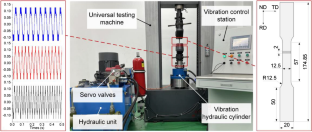Constitutive modeling and deformation analysis of W-temper and peak aged 7075 alloy sheets under low frequency vibration assisted tension
Abstract
Low frequency vibration assisted forming characterized with high excitation force can reduce the forming load and improve the surface quality, and has been proven to have a promising application in forming processes of high-strength metals. In this work, the plastic deformation behavior of 7075 aluminum alloy sheets under low frequency vibration was studied. The low frequency vibration assisted tension (LFVT) tests were performed on 7075-WT and 7075-T6 sheets. The obvious stress oscillation (called the stress superposition effect) and stress softening/hardening effect were observed in the experimental stress–strain relation under LFVT. After explaining the effects with the thermal activation theory, a physical constitutive model was developed by introducing the mechanical work done by low frequency vibration, a critical vibration energy value, and Hooke’s law into the thermal activation framework. The VUHARD user-subroutine was used to embed the developed model into ABAQUS/Explicit to perform the finite element (FE) analysis of the LFVT tests. The comparison of the predicted load through the FE simulation with the experimental one demonstrated the developed model could precisely describe the stress–strain relation under LFVT. The simulation result with different vibration modes also showed that the vibration softening effect gradually increased as the amplitude or frequency increased. The influence of the amplitude on vibration softening stress was much greater than that of the frequency.


 求助内容:
求助内容: 应助结果提醒方式:
应助结果提醒方式:


